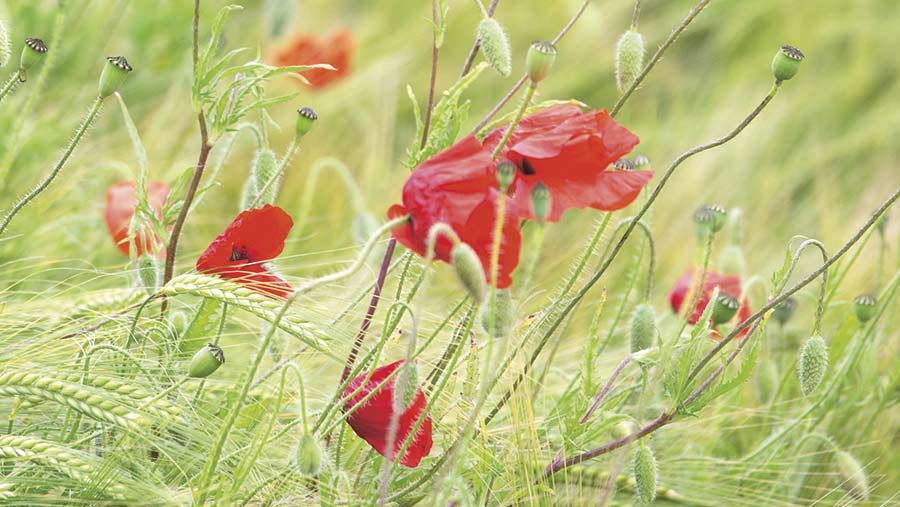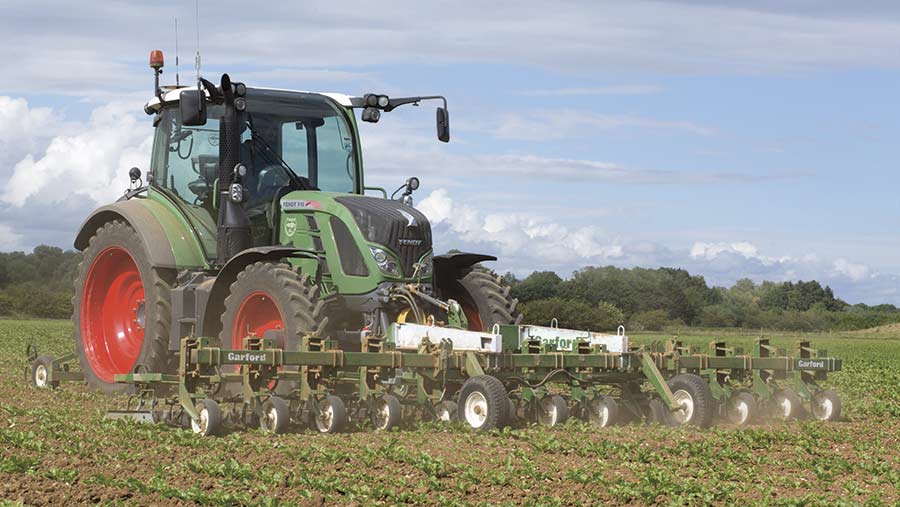How to get on top of broad-leaved weeds
Apart from reducing crop yields, broad-leaved weed infestations can slow down harvesting and contaminate the grain sample.
In addition, the seed of most broad-leaved weed species is more persistent in the soil than that of grassweeds and will survive for 10 or more years.
See the other articles in this four-part weed series:
Therefore, preventing seed return is an important part of any broad-leaved weed strategy, along with effective use of chemistry.
Species
There is wide range of broad-leaved weeds found in UK arable fields.
Among the most common are cleavers, speedwell, mayweed, groundsel, charlock, cranesbill, chickweed, filed pansy, sow thistle, bindweed, fat hen, shepherd’s purse, creeping thistle, fool’s parsley, docks, knotgrass and poppy.

Poppies © Tim Scrivener
However, they vary in competitiveness and the losses they can cause to crops.
Weed competition |
|
| Most competitive | Cleavers, charlock, volunteer OSR, mayweed and poppy |
| Moderately competitive | Chickweed, black bindweed, fat hen, knotgrass, thistles, speedwell, crane’s bill, groundsel and fool’s parsley |
| Weakly competitive | Field pansy, scarlet pimpernel and parsley piert |
How they spread
Different broad-leaved weed species emerge at specific times of the year. While some are autumn germinators, others only appear in the spring and there are species that germinate in both autumn and spring.
Most can only emerge successfully from the top 3cm of soil, although there are some exceptions and those species with larger seeds will emerge from depths of up to 15cm.
Infestations usually consist of a mix of different species, making management more complex. Where herbicide practice has changed in recent years, species that were trivial have tended to become more problematic.
Weed management – herbicides
Growers should know which broad-leaved weed species are present so that the most appropriate herbicide can be used. Control is dependent on herbicides on most farms, so maintaining the availability and efficacy of a wide range of herbicides is essential.
While many of the acetolactate synthase (ALS)-inhibiting herbicides are effective, they are also prone to resistance. As a result, they should be used with other modes of action, in mixes and sequences, to reduce this risk.
There are already confirmed cases of resistance to this chemistry in poppy, chickweed and mayweed.
This year, the first new herbicide active for more than 20 years to control broad-leaved weeds in cereals was launched. The synthetic auxin halauxifen-methyl offers farmers a new mode of action, which will be valuable in resistance management.
Post-emergence herbicides must be applied according to label recommendations. Waiting until the spring to complete your weed control may mean the weeds have become too big for effective control, as their sensitivity changes with growth stage. The best control is achieved by treating the weeds when they are still small.
The pre-emergence herbicides used to control grassweeds will often give good control of broad-leaved weeds. However, residuals used in the autumn are unlikely to control weeds that germinate in the spring.
Weed management – cultural control
Preventing any one dominant broad-leaved weed species can be done with rotations, which include both spring- and autumn-sown crops. Likewise, the inclusion of non-cereal break crops will make a difference to the weed spectrum.
With autumn-sown crops, minimum tillage and direct drilling tend to reduce broad-leaved weed numbers, as does establishing spring crops with minimal soil disturbance.
Hoeing and harrowing can also be effective, but must be carried out while the weeds are still small.

© Tim Scrivener
The other technique that works well is the use of a strongly competitive crop, as many broad-leaved weeds are very susceptible to competition.
Resistance warning
Three broad-leaved weed species – common poppy, chickweed and scentless mayweed – have developed resistance to sulfonylurea herbicides. In addition, groundsel has developed resistance to metribuzin and metamitron.
Where resistance has been confirmed, affected herbicides should always be used with other unaffected active ingredients, either as a tank mix or a sequence.
Given the likelihood of resistance increasing rapidly, growers are being advised to bring forward their decision-making and application timings.
Difficult weed populations require a programmed approach that includes some element of soil-acting residual herbicide in the autumn, followed by a post-emergence application while the target plant is still susceptible.
“The sustainable management of broad-leaved weeds should be a priority,” stresses John Cussans, weed specialist at Niab Tag.
“We can learn from what’s happened with grassweeds and prevent the same thing happening again.”
Herbicide resistance in broad-leaved weeds – top tips
- Herbicide resistance in broad-leaved weeds has been confirmed in the UK.
- Most control failures are still associated with product choice and/or application timing.
- Use recommended maximum rates to control high-risk weeds and those that are hard to control because of their growth stage.
- Know how to identify broad-leaved weed growth stages.
- Pay attention to detail and follow best practice.
- Use some cultural control to reduce reliance on herbicides.
- Never rely on a single herbicide mode of action.
- Don’t use herbicides containing the same mode of action more than once in the season.
- Use tank mixes and sequences where resistance is suspected.

